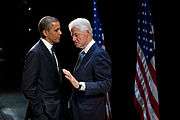Triangulation (politics)

In politics, triangulation is the strategy in which a political candidate presents their ideology as being above or between the left and right sides (or "wings") of a traditional (e.g. American or British) democratic political spectrum. It involves adopting for oneself some of the ideas of one's political opponent. The logic behind it is that it both takes credit for the opponent's ideas, and insulates the triangulator from attacks on that particular issue.
Origins
The term was first used by U.S. President Bill Clinton's former chief political advisor Dick Morris as a way to describe his strategy for getting Clinton reelected in the 1996 presidential election. In Dick Morris' words, triangulation meant "the president needed to take a position that not only blended the best of each party's views but also transcended them to constitute a third force in the debate."[1] In news articles and books, it is sometimes referred to as "Clintonian triangulation".[2][3][4] Morris advocated a set of policies that were different from the traditional policies of the Democratic Party. These policies included deregulation and balanced budgets. One of the most widely cited capstones of Clinton's triangulation strategy was when, in his 1996 State of the Union Address, Clinton declared that the "era of big government is over."[5]
Recent use
Politicians alleged to have used triangulation more recently include US President Barack Obama,[6][7] former Senator Hillary Clinton, Tony Blair with "New Labour" in the United Kingdom, Jean Chrétien and Paul Martin with the Liberal Party of Canada, Fredrik Reinfeldt with "The New Moderates" in Sweden, and Bob Hawke, Paul Keating, and Kevin Rudd of the Australian Labor Party. In France, the Socialist candidate in the 2007 presidential election, Ségolène Royal, advocated “military supervision” (encadrement militaire) for first offenders.
During the 2010 State of the Union Address, President Obama insisted that he would remain with his agenda in the face of criticism, rather than resort to triangulation.[5]
See also
References
- ↑ Morris, Dick (1999). Behind the Oval Office : getting reelected against all odds (2. ed.). Los Angeles: Renaissance Books. p. 80. ISBN 978-1580630535.
- ↑ Trende, Sean (2012). The lost majority : why the future of government is up for grabs-- and who will take it (1st ed.). New York: Palgrave Macmillan. ISBN 0230116469.
- ↑ Goldberg, Jonah (December 18, 2007). "Clintonian triangulation comes full circle". Los Angeles Times. Retrieved 29 December 2014.
- ↑ Lind, Michael; Halstead, Ted (2013). The radical center the future of american politics (Unabridged. ed.). New York: Anchor Books. ISBN 9781400033294.
- 1 2 Sanger, David E. (2010-01-29). "Where Clinton Turned Right, Obama Plowed Ahead". The New York Times. Retrieved 2010-05-26.
- ↑ How tax cut revolt helps Obama: It's a page from Clinton playbook "Perhaps President Obama's tax-cut deal with the GOP was astute, after all. While he angered liberals, he also won back some independent support – an example of Clintonian 'triangulation.'"
- ↑ "Matt Frei's diary: Groundhog Day". BBC News. 2010-02-03. Retrieved 2010-05-26.
